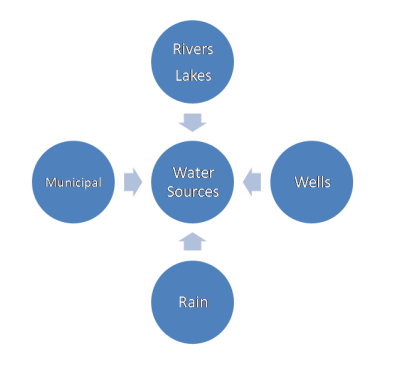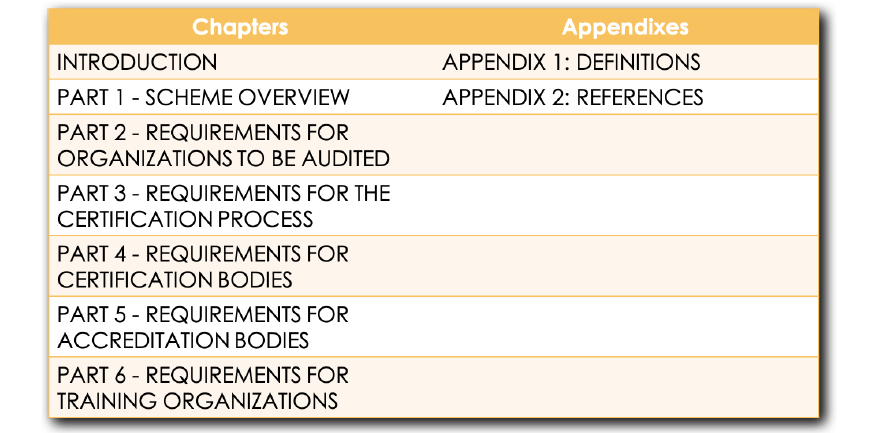Introduction
As anticipated, at the end of May this year, the new version of FSSC 22000 was released. It is still very fresh for everyone so I would like to take this opportunity to share with you a brief presentation summarizing its changes and updates. Later this year in October, I will provide deeper insights, diagrams and some tools to use for implementation, when I release a new e-book following last year’s ISO 22000 Explained in 25 Diagrams!
ISO 22000 updated its food safety management system in June 2018 and consequently an updated FSSC 22000 was compulsory. FSSC 22000 Version 5 rolled out with more changes than the simple adoption of 2018’s ISO 22000 version. FSSC 22000 Version 5 scheme presents immediately on introduction that there were five factors for initiating the update.

Figure 1 - Factors for iniciatiing FSSC 22000
MOTIVATION AND STRUCTURE
All scheme documentation is available on FSSC 22000 website under the menu Scheme. It is notable that up to the moment of the publication of this article, there is no gap analysis provided between 4.1 version and version 5. But one thing is clear at first glance, the scheme is now all under the same document with 6 chapters and 2 appendixes.

Table 1 - FSCC 22000 scheme structure
From the perspective of the food safety professional who is going to implement the scheme Introduction, Part 1 and Part 2 are certainly the ones to take a closer look at. In this article we restricted the analyses precisely to these 3 sections. Another important section and so often overlooked are definitions. In Appendix 1 you can find 58 definitions, 9 of which are common to ISO 22000:2018 (they are either identical or so similar that the differences do not change the essence of ISO definitions). Regarding the other 49 definitions, I urge you to take a look to deepen your knowledge on how the scheme defines Black-out days, Critical Nonconformity, Follow-up audit, Product recalls, Product withdrawal, Serious event, and Unannounced audit among others.
Introduction and Scheme Overview
The Introduction Section basically presents the factors that motivated the update and the scheme organization.
Regarding Part 1 - Scheme Overview there are a couple of changes worth mentioning.
1. The objectives of the scheme are enlarged. Beside maintain reliable Register of Certified Organizations, 4 more items were added around promotion and recognition of food safety and quality management systems and providing information and support to their certification. It also presents how the Foundation FSSC 22000 endeavors to achieve these objectives.
2. The food chain categories (and sub-categories) under which organizations may apply for certification are in line with ISO/TS 22003:2013 and presented in a table
followed by a brief presentation and examples for each category.
Requirements for Organisations to be Audited
Immediately, it is defined that commencing January 2020, organizations applying for FSSC 22000 V5 certification will be audited against ISO 22000:2018 (instead of the obsolete 2005 version). Additional requirements and sector specific prerequisite programs are maintained as requirements (as is with ISO 9001 if organizations apply for the FSSC 22000-Quality certification).
Prerequisite Programs PRPs
In the section of the scheme dedicated to prerequisites (Clause 2.4) is now pointed out that not only PRP is mandatory the application of technical specifications detailing the prerequisites programs but also that these PRP requirements are specified in the ISO/TS 22000-x, NEN/NTA 8059 and/or the BSI/PAS 221 standards. In version 4.1 the PRP clause (2.1.3) had much more content but some may have been removed due to its similarities with information now presented in clause 8.2 of the ISO 22000:2018.
Additional Requirements
In Clause 2.5, the scheme presents 9 additional requirements. The only change is: Management of natural resources was removed and Transport and delivery is in place. Note the additional requirements 6 to 9 are specific for some food chain categories.
In Management of services a whole lot of text was deleted (sub-clause 1 and 2), in my opinion because the issues are addressed in ISO 22000:2018 clause 7.1.6. The essence of the additional requirement Product labeling remains the same.
Food Defense requirement compels the development of two documents. A documented procedure to conduct threat assessment and implement mitigation measures (previously referred as control measures) and a documented food defense plan.

Figure 2 - Additional requirements

The Food Fraud Mitigation clause is basically identical to the Food Defense changing threats for vulnerabilities. Both plans signify the importance of being regularly updated which was not referred to in Version 4.1.
The rules to use the FSSC 22000 logo were updated in the clause with references to Certifications Body and Training Organization. In previous versions, this pertained only to certified organizations.
The Management of allergens requirements clause was cut in half by removing (from the previous version) sub-clause 1c) Validation and Verification of Effective Implementation (of the allergen management plan) and sub-clause 2, now addressed in the Product Labelling requirement (2.5.2).
The essence of version 4.1 Environmental Monitoring required a program to verify the effectiveness of cleaning and sanitation. The new version has a more holistic approach by requiring a risk-based environmental monitoring program, a documented procedure for the evaluation of the effectiveness of all controls on preventing contamination from the manufacturing environment and regular trend analysis from monitoring activities.
Formulation of Products and Transport and Delivery are requirements specifically for food chain category D and FI, respectively.
When you should be ready
The sooner the better. Time flies! One year has passed since the ISO 22000:2018 publication... Can you believe it? If your organization is FSSC 22000 certified, already the clock is ticking. You have to be audited against FSSC 22000 Version 5 during 2020. So hurry! ... because you have to adapt your food safety management system to the new ISO 22000:2018 and then also adopt FSSC 22000 Version 5 requirements.
As you may have noticed by the diagrams within, I am in the process of preparing a new e-book to help you in this transition. I am eager to share it with you all. For that matter, I share with you that I will talk with FSSC in July to better understand their perspective in the update and also present some perceived challenges.
Disclaimer:
The information contained on this article is based on research done in the last months and the author personal experience and opinion. It is not intended to represent the view of any organization he works for or collaborate with. The author will not be held liable for the use or misuse of the information provided in the article.
About the Author
Nuno F. Soares, Ph.D., is an author, consultant, and trainer in food safety. He his a Food Engineer Specialist and senior member of the Portuguese Engineering Professional Association. He has over 20 years of experience in food industry as quality and plant manager. You can reach him at www.nunofsoares.com
This Article Was republished with the Permission of Nuno F Soares.







